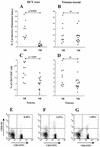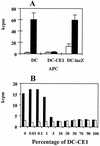Abnormal priming of CD4(+) T cells by dendritic cells expressing hepatitis C virus core and E1 proteins
- PMID: 11967322
- PMCID: PMC136154
- DOI: 10.1128/jvi.76.10.5062-5070.2002
Abnormal priming of CD4(+) T cells by dendritic cells expressing hepatitis C virus core and E1 proteins
Erratum in
- J Virol. 2004 Oct;138(1):193
Abstract
Patients infected with hepatitis C virus (HCV) have an impaired response against HCV antigens while keeping immune competence for other antigens. We hypothesized that expression of HCV proteins in infected dendritic cells (DC) might impair their antigen-presenting function, leading to a defective anti-HCV T-cell immunity. To test this hypothesis, DC from normal donors were transduced with an adenovirus coding for HCV core and E1 proteins and these cells (DC-CE1) were used to stimulate T lymphocytes. DC-CE1 were poor stimulators of allogeneic reactions and of autologous primary and secondary proliferative responses. Autologous T cells stimulated with DC-CE1 exhibited a pattern of incomplete activation characterized by enhanced CD25 expression but reduced interleukin 2 production. The same pattern of incomplete lymphocyte activation was observed in CD4(+) T cells responding to HCV core in patients with chronic HCV infection. However, CD4(+) response to HCV core was normal in patients who cleared HCV after alpha interferon therapy. Moreover, a normal CD4(+) response to tetanus toxoid was found in both chronic HCV carriers and patients who had eliminated the infection. Our results suggest that expression of HCV structural antigens in infected DC disturbs their antigen-presenting function, leading to incomplete activation of anti-HCV-specific T cells and chronicity of infection. However, presentation of unrelated antigens by noninfected DC would allow normal T-cell immunity to other pathogens.
Figures







Similar articles
-
Hepatitis C virus structural proteins impair dendritic cell maturation and inhibit in vivo induction of cellular immune responses.J Virol. 2003 Oct;77(20):10862-71. doi: 10.1128/jvi.77.20.10862-10871.2003. J Virol. 2003. PMID: 14512536 Free PMC article.
-
Impaired allostimulatory capacity of peripheral blood dendritic cells recovered from hepatitis C virus-infected individuals.J Immunol. 1999 May 1;162(9):5584-91. J Immunol. 1999. PMID: 10228041
-
Induction of primary human T cell responses against hepatitis C virus-derived antigens NS3 or core by autologous dendritic cells expressing hepatitis C virus antigens: potential for vaccine and immunotherapy.J Immunol. 2006 May 15;176(10):6065-75. doi: 10.4049/jimmunol.176.10.6065. J Immunol. 2006. PMID: 16670315
-
Hepatitis C virus (HCV): a review of immunological aspects.Int Rev Immunol. 2008;27(6):497-517. doi: 10.1080/08830180802432178. Int Rev Immunol. 2008. PMID: 19065353 Review.
-
Dendritic cell-based immunity and vaccination against hepatitis C virus infection.Immunology. 2012 Aug;136(4):385-96. doi: 10.1111/j.1365-2567.2012.03590.x. Immunology. 2012. PMID: 22486354 Free PMC article. Review.
Cited by
-
Expression of hepatitis C virus core protein in hepatocytes does not modulate proliferation or apoptosis of CD8+ T cells.Yonsei Med J. 2005 Dec 31;46(6):827-34. doi: 10.3349/ymj.2005.46.6.827. Yonsei Med J. 2005. PMID: 16385660 Free PMC article.
-
Dendritic Cells in HIV-1 and HCV Infection: Can They Help Win the Battle?Virology (Auckl). 2013 Feb 11;4:1-25. doi: 10.4137/VRT.S11046. eCollection 2013. Virology (Auckl). 2013. PMID: 25512691 Free PMC article. Review.
-
Prospects for dendritic cell vaccination in persistent infection with hepatitis C virus.J Clin Virol. 2004 Aug;30(4):283-90. doi: 10.1016/j.jcv.2004.03.006. J Clin Virol. 2004. PMID: 15163415 Free PMC article. Review.
-
Detection of Antigen-Specific CD8+ T Cells in the Livers of HCV Core Transgenic Mice.Methods Mol Biol. 2019;1911:453-458. doi: 10.1007/978-1-4939-8976-8_31. Methods Mol Biol. 2019. PMID: 30593645 Free PMC article.
-
Blockade of PD-1/B7-H1 interaction restores effector CD8+ T cell responses in a hepatitis C virus core murine model.J Immunol. 2008 Apr 1;180(7):4875-84. doi: 10.4049/jimmunol.180.7.4875. J Immunol. 2008. PMID: 18354211 Free PMC article.
References
-
- Alexander, J., J. Sidney, S. Southwood, J. Ruppert, C. Oseroff, A. Maewal, K. Snoke, H. M. Serra, R. T. Kubo, A. Sette, and H. M. Grey. 1994. Development of high potency universal DR-restricted helper epitopes by modification of high affinity DR-blocking peptides. Immunity 1:751-761. - PubMed
-
- Auffermann-Gretzinger, S., E. B. Keeffe, and S. Levy. 2001. Impaired dendritic cell maturation in patients with chronic, but not resolved, hepatitis C virus infection. Blood 97:3171-3176. - PubMed
-
- Bain, C., A. Fatmi, F. Zoulim, J. P. Zarski, C. Trepo, and G. Inchauspe. 2001. Impaired allostimulatory function of dendritic cells in chronic hepatitis C infection. Gastroenterology 120:512-524. - PubMed
-
- Banchereau, J., and R. M. Steinman. 1998. Dendritic cells and the control of immunity. Nature 392:245-252. - PubMed
-
- Bruna-Romero, O., J. J. Lasarte, G. Wilkinson, K. Grace, B. Clarke, F. Borras-Cuesta, and J. Prieto. 1997. Induction of cytotoxic T-cell response against hepatitis C virus structural antigens using a defective recombinant adenovirus. Hepatology 25:470-477. - PubMed
Publication types
MeSH terms
Substances
LinkOut - more resources
Full Text Sources
Other Literature Sources
Research Materials

